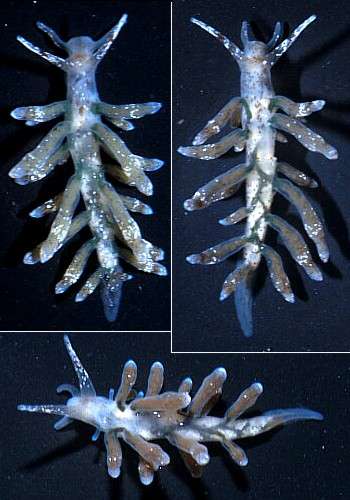
Eubranchus rupium
(Moller, 1842)
Order: NUDIBRANCHIA
Suborder: AEOLIDINA
Family: Eubranchidae
DISTRIBUTION
As E. rupium it is known from Greenland, Denmark, Sweden, Norway. Reported here from the Netherlands and eastern North America. As E. olivaceus known from west coast of Nth America.
PHOTO
Texel, the Netherlands, 8 May 1987. PHOTO: Rob Dekker.
Grows to about 12mm. It preys upon the calyptoblastic hydroid Laomedea longissima.
See Rob Dekker's message, and photo of egg masses, below.
Martynov (1998) considers that E. olivaceus from the northeast Pacific is a synonym of E. rupium from the north Atlantic. Lemche, as described in Just & Edmunds (1985:114), also considered E. olivaceus and E. rupium to be the same species. [see Jeff Goddard's message.]
References:
• Bleakney, J.S. (1996) Sea slugs of Atlantic Canada and the Gulf of Maine. Nimbus Publishing and The Nova Scotia Museum. 216pp.
• Gould, A. A. 1870. Report on the Invertebrata of Massachusetts, published agreeably to an order of the legislature. Second edition, comprising the Mollusca. Edited By W. G. Binney, v + 524pp. pls. XVI-XXVII. [Nudibranchia pp. 225-253, pls. 16-22]. Boston: Wright & Binney, State Printers.
• Just, H. & Edmunds, M. (1985) North Atlantic Nudibranchs (Mollusca) seen by Henning Lemche. Ophelia, Supplement 2. 170pp.
• Lambert, W.J. (1991) Coexistence of hydroid-eating nudibranchs: recruitment and non-equalibrial patterns of occurrence. Journal of Molluscan Studies, 57(4), Supplement, T.E.Thompson Memorial Issue: 35-47.
• Martynov, A.V. (1998) Opisthobranch mollusks (Gastropoda: Opisthobranchia) of the family Eubranchidae: Taxonomy and two new species from the Sea Of Japan. Zoologicheskii Zhurnal, 77: 763-777.
• Meyer, K.B. (1971) Distribution and zoogeography of fourteen species of nudibranchs of northern New England and Nova Scotia. Veliger, 14(2): 137-152.
• O'Donoghue, C.H. (1922) Notes on the Nudibranchiate Mollusca from the Vancouver Island Region. III. Records of species and distribution. Transactions of the Royal Canadian Institute, Toronto, 14(1): 145-167.
Rudman, W.B., 2003 (July 14) Eubranchus rupium (Moller, 1842). [In] Sea Slug Forum. Australian Museum, Sydney. Available from http://www.seaslugforum.net/find/eubrrupi
Related messages
Eubranchus olivaceus? from British Columbia
March 5, 2008
From: Laura McLeod


Hello,
I thought I'd add another specimen into the Eubranchus mix. I think this is Eubranchus olivaceus, having used the Kozloff Marine Invertebrates key for the Pacific Northwest. It was collected on hydroids growing off the docks and these pictures were taken in the lab. I have also included a shot of the radula, taken under a light microscope at 40x with a scale bar of 20um.
Locality: Bamfield , 0.5 m, British Columbia, Canada, Pacific Ocean, 15 July 2007, On hydroids on the docks. Length: 2 mm. Photographer: Laura McLeod.
Cheers
Laura McLeod
lmcleod@gmail.com
McLeod, L.E., 2008 (Mar 5) Eubranchus olivaceus? from British Columbia. [Message in] Sea Slug Forum. Australian Museum, Sydney. Available from http://www.seaslugforum.net/find/21163
Dear Laura,
Aren't these little devils fun. Yes indeed this is Eubranchus rupium (Moller, 1842), previously E. olivaceus(O'Donoghue, 1922). I cannot make out the lateral teeth in your radula prep, although the 5-6 denticles on the rachidian tooth are obvious. Bottom line, the very distinctive coloration on the body gives it away.
Best wishes,
Dave Behrens
Eubranchus rupium? from British Columbia
September 12, 2007
From: Clinton Bauder


Hi Bill,
Part two of three in a series of Eubranchus. This one looks to me like Eubranchus rupium based on the white flecks on the rhinophores, more reddish markings and the transparent mantle. But, as I say in my previous message I'm having trouble distinguishing these guys.
Locality: Browning Pass, 15 meters, British Columbia, Canada, Pacific, 27 August 2007, Rock Wall. Length: 5 mm. Photographer: Clinton Bauder.
Clinton Bauder
gecko1@apple.com
Bauder, C., 2007 (Sep 12) Eubranchus rupium? from British Columbia. [Message in] Sea Slug Forum. Australian Museum, Sydney. Available from http://www.seaslugforum.net/find/20646
Hi Clinton,
Well the plot thickens. I agree with the ID, although not really typical. Again, you have documented the eggs, which are typical eubranchid. I think I'd like Sandra Millen and Jeff Goddard to chime in on this one
Thanks for sharing,
Dave Behrens
Eubranchus rupium with eggs
May 22, 2006
From: John de Jong

Hello Bill
Here are some additional pics of Eubranchus rupium from the Netherlands. I hope you can use them
Locality: Den Osse, 7 meters, Netherlands, Grevelingen, 08-04-2006, Salt water without current. Length: 15-25 mm. Photographer: John de Jong.
John de Jong.
john@jojodive.nl
de Jong, J., 2006 (May 22) Eubranchus rupium with eggs. [Message in] Sea Slug Forum. Australian Museum, Sydney. Available from http://www.seaslugforum.net/find/16543
Dear John,
Thanks for these photos.
Best wishes,
Bill Rudman
Re: Eubranchus olivaceus?
May 30, 2003
From: Alan Shepard
NOTE added 14 July 2003: Following Jeff Goddard's message suggesting that E. olivaceus is a synonym of Eubranchus rupium, I have re-identified these east coast animals as E. rupium. - Bill Rudman
Bill -
Thanks for the information and comments concerning the photo of Eubranchus olivaceus or 'Aeolis despecta'. You asked when I had observed the creature in question. The photo was taken on May 4, 2003. I had also observed the same nudibranch in early April, 2002. I have to agree the nudibranch I photographed does indeed match the color plate from Gould.
Thanks for all the research you did on the this.
Sincerely,
Alan Shepard
Tolland, CT, USA
alan.chepard@snet.net
Shepard, A., 2003 (May 30) Re: Eubranchus olivaceus?. [Message in] Sea Slug Forum. Australian Museum, Sydney. Available from http://www.seaslugforum.net/find/10081Thanks Alan,
Just to clarify. The name Gould used - Aeolis despecta - is not available for this animal. Gould identified his animals with an animal from the UK which Johnstone had named Aeolis despecta but is now considered a synonym of Tergipes tergipes. One possibility is that your animal is a very large Tergipes tergipes, but if so, it is certainly much larger than European animals. Otherwise it probably needs a new name. But first its teeth need to be looked at so we have some idea what family it belongs to.
Bill Rudman
Eubranchus olivaceus? from Massachusetts
May 28, 2003
From: Alan Shepard
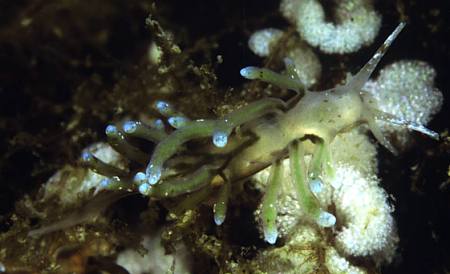
NOTE added 14 July 2003: Following Jeff Goddard's message suggesting that E. olivaceus is a synonym of Eubranchus rupium, I have re-identified these east coast animals as E. rupium. - Bill Rudman
Bill -
Here are a couple of photos of Eubranchus olivaceus, a species you don't have represented on the Forum.
The photos were taken in Woods Hole, Massachusetts, USA under the Woods Hole Oceanographic Institute's pier in about 4 meters of water. I spotted a hydroid covered with eggs and easily found a number of E. olivaceus. They were all about 9 mm long.
According to Bleakney's book Sea Slugs of Atlantic Canada and the Gulf of Maine, it is a rare species first found on our coast in 1966 off Maine. It is also found on the west coast of the USA and Canada. I found a matching photo of one in David Behrens book, Pacific Coast Nudibranchs.
I'm not sure if the eggs in the photos belong to it or another species. All sources indicate that E. olivaceus is often found in the company of other Eubranchus species and Tergipes tergipes. In fact if you look closely at one of the photos you'll see what I believe is E. exiguus.
Sincerely,
Alan Shepard
alan.chepard@snet.net
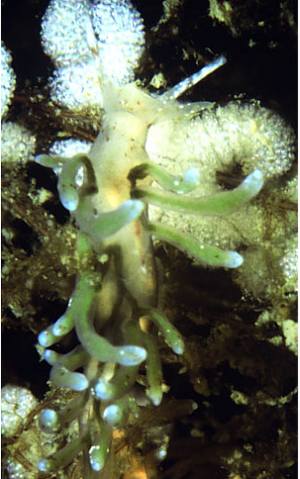
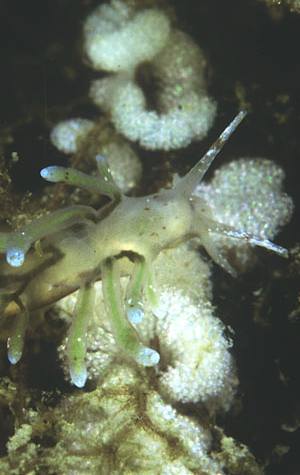
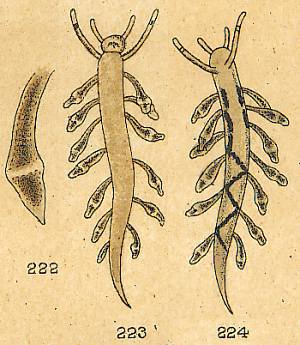
Dear Alan,
This is an interesting find. Can you give me a date please? Reading O'Donoghue's description of Eubranchus olivaceus and the one photo I can find of it I have doubts about Bleakney's identification of your east coast animal. I am also pretty sure that it was found in Massachusetts a century before Bleakney's 1966 date. I have included here a scan of some paintings from Gould, 1870 [Plate 16] of what I think is the same animal.
Gould identifies it as Aeolis despecta Johnstone and describes it as:
"Animal colourless with a zigzag olive-coloured stripe along the back; branchiae large, ovate, in a single series along each side; dorsal tentacles long; angles of foot not produced. .... 'now and then zigzag stripe passes from one papillae to another on the same side. Orange ring about two thirds the way up the dorsal tents. Cerata much dilated near tip which is clear and transparent, in some aspects seeming as if encircled by a white ring. Hepatic substance [digestive gland duct] is olive green. Anterior angles of the foot rounded. Length about 1/4 inch.'"
Gould lists a number of records from Massachusetts. He also notes that the radula consists of a single row of teeth which suggests that he either missed the large lateral tooth on each side of the ventral tooth, or that this is not a species of Eubranchus. Perhaps this is a second species of Tergipes or perhaps Tergipes tergipes grows to a much larger size in Nth America than it does in Europe. The name Aeolis despecta Johnstone is based on European specimens and is a synonym of Tergipes tergipes. Clearly the first step would be to look at its radula.
•Gould, A. A. 1870. Report on the Invertebrata of Massachusetts, published agreeably to an order of the legislature. Second edition, comprising the Mollusca. Edited By W. G. Binney, v + 524pp. pls. XVI-XXVII. [Nudibranchia pp. 225-253, pls. 16-22]. Boston: Wright & Binney, State Printers.
Best wishes,
Bill Rudman
Eubranchus rupium from Holland
September 10, 1999
From: Rob Dekker


Dear Bill,
Here are some slide scans of the aeolidacean nudibranch Eubranchus rupium (Möller, 1842) and its spawn on the hydroid Laomedea longissima, collected on 8 May 1987 at Texel, the Netherlands.
Eubranchus rupium is a northern species, reaching its southern limit in the East Atlantic along the continental North Sea coast near the Dutch/Belgian border. In the Netherlands it reproduces in winter and early spring, and is in particular abundant after severe winters. It preys exclusively upon the calyptoblastic hydroid Laomedea longissima.
I have sent you pictures of three different specimens, to illustrate the individual variability in colouration of the diverticulae of the digestive gland in body and cerata. Note also the variation in
intensity of the white and red-brown pigmentation of the skin of the body, rhinophores and cerata. You can add this species to your list of Dutch nudibranchs.
With kind regards,
Rob Dekker
Netherlands Institute for Sea Research
P.O. Box 59
1790 AB Den Burg
The Netherlands
rdekker@nioz.nl
Dekker, R., 1999 (Sep 10) Eubranchus rupium from Holland. [Message in] Sea Slug Forum. Australian Museum, Sydney. Available from http://www.seaslugforum.net/find/1323Thanks Rob,
This species gives us a good view of the branching of the main digestive gland ducts in the body.
Best wishes,
Bill Rudman.
